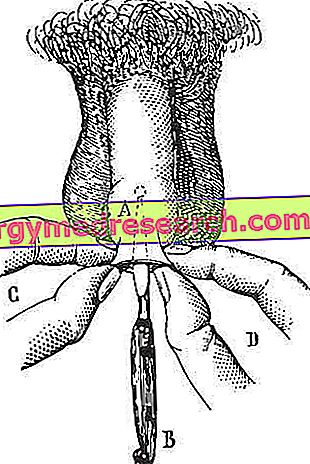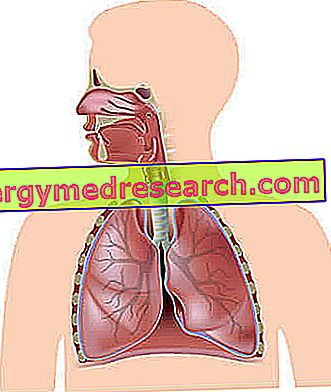Generality
The frenuloplasty is the surgical operation aimed at remodeling the penis, in men with a short frenulum.

From a practical point of view, frenuloplasty involves the incision of the penile frenulum and the application of one or more sutures at the level of this incision, with the final aim of eliminating the anomalies that cause the short frenulum.
Duration of approximately 15-30 minutes, frenuloplasty is a safe and effective intervention.
A brief review of what the penis frenulum is
Also known as the frenulum of the foreskin of the penis or the frenulum of the penis, the frenulum of the penis is the thin band of elastic tissue which, in the male reproductive organ, connects the lower part of the glans to the foreskin .
Visible only when the penis is erect, the penile frenulum has a role in the sliding mechanics of the foreskin with respect to the glans and a role in sexual dynamics:
- As regards the first role, it limits the distension of the foreskin, when the penis goes into erection, and allows the correct sliding of the foreskin over the glans, when the penis returns flaccid;
- As for the second role, it is an area rich in nerve endings, which allow man to experience pleasure during sexual intercourse or to feel pain if his penis is subjected to violent maneuvers.

Figure (of the penis): Anatomy of the pen ; The limbs and foreskin are, respectively, the head of the penis and the sliding skin fold, which covers part or the whole of the glans, when the penis is flaccid.
What is frenuloplasty?
The frenuloplasty is the surgical procedure for remodeling the penile frenulum, which is applied in the presence of the condition known as the short frenulum or short frenulum .
Indications
In medicine, "frenulo corto" is the name of the anatomical anomaly whereby the penile frenulum is shorter than the norm.
Possible outcome of repeated microtraumas during sexual activity or of retraent scarring lesions at the level of the foreskin, the short frenulum jeopardizes, more or less markedly, the mechanism of uncovering the glans, during a penile erection; this can have consequences:
- Pain during sexual intercourse (dyspareunia);
- Discomfort during erection;
- Difficulty in maintaining an erection;
- Injury or rupture of the frenulum, due to improper rubbing of the penile frenulum against the vaginal walls (obviously during the sexual act). Breaking the frenulum involves pain and blood loss;
- Premature ejaculation.
What is the use of frenuloplasty in the presence of a short frenulum?
In the presence of a short frenulum, frenuloplasty serves to eliminate - or at least reduce - the anatomical anomaly of the penile frenulum, in such a way as to allow the correct sliding of the foreskin again with respect to the glans.
It should be pointed out that not all cases of short frenulum require frenuloplasty; the latter, in fact, is indicated in symptomatic cases, ie when the condition of a short frenulum is responsible for symptoms.
Does frenuloplasty have other applications?
In addition to the presence of a short frenulum, frenuloplasty could also be applied among men where the closure of a laceration of the penile frenulum has partially altered the anatomy and functionality of the latter.
The use of frenuloplasty in the aforementioned circumstances is very rare, since, generally, the process of recovery from a frenulum rupture occurs without complications and has an excellent prognosis.
Preparation
The frenuloplasty requires special preparation, which consists of:
- Blood and urine tests . They are used to assess the general health status of the possible patient, as well as his suitability for surgical procedures;
- Electrocardiogram . It has the same purpose as blood and urine tests;
- General practitioner meeting - patient . On this occasion, the doctor who should perform the frenuloplasty personally assesses the patient's suitability for surgery; specifically, investigate:
- Current drug therapies. During an operation such as frenuloplasty, all those drug therapies that alter the normal coagulation process (aspirin, warfarin, etc.) should be suspended, because they could cause serious blood loss;
- Allergies to drugs, sedatives or anesthetics. It is fundamental information for the success of frenuloplasty, as the execution of the latter requires the use of drugs for sedation, anesthesia, etc .;
- Presence of chronic diseases;
- Presence of heart diseases.
- Exposure by the attending physician of all the details of the frenuloplasty (pre-operative instructions, procedure, post-operative phase, risks, recovery times, etc.). In general, the doctor who will carry out the intervention exposes all this information at the end of the assessments related to the suitability of the patient.
Pre-operative instructions
Pre-operative instructions are all instructions that a patient must have the foresight to follow, in the days preceding a certain procedure.
In the case of frenuloplasty, the pre-operative instructions for future patients are:
- Quit smoking (clearly, if the patient is a smoker). Cigarette smoking increases the risk of infections arising from surgical incisions made during frenuloplasty; moreover, it alters the flow of blood to the skin and this slows down the healing of the aforementioned incisions.
According to experts, smokers should begin smoking abstinence at least 2 weeks before surgery and implement it at least 2 weeks after the operation.
- Temporarily stop, starting a few days before the frenuloplasty, any drug therapy that alters the normal blood clotting process;
- On the day of the procedure, appear at full fast for at least 8 hours. This means that, if frenuloplasty is expected in the morning, the last meal the patient can take is the dinner the day before the operation.
Fasting is part of the pre-operative instructions of any surgical procedure, which includes general anesthesia or which, in particular cases, could include general anesthesia (NB: frenuloplasty falls under the second circumstance).
- Ask a relative or close friend for support on the day of the procedure, especially with regards to returning home, once the operation is completed.
Procedure
Before the actual frenuloplasty begins, the patient must wear a hospital gown to replace his or her clothes, sit on an operating table specially prepared for him, receive anesthesia (which can be general or local depending on the circumstances) and wait for the effects.
A classic frenuloplasty procedure, therefore, involves:
- The incision of the penile frenulum. This incision can be transverse, "Z" or "Y", depending on what the operating surgeon believes is best suited to the patient's needs;
- The remodeling of the penile frenulum, in order to make it longer;
- The application of sutures in a longitudinal direction, in such a way as to favor the healing of surgical incisions according to the final aims of the operation;
- The penile bandage with purely protective purposes.
Once the penile bandage is performed, frenuloplasty can be considered complete.
Anesthesia
The choice between general anesthesia and local anesthesia rests with the surgeon who will perform frenuloplasty; on this choice, factors such as the complexity of the remodeling, the age of the patient, the experience of the surgeon to operate in one or the other circumstance affect.
To take care of the practical execution of anesthesia - general or local - is an anesthesiologist.
GENERAL ANESTHESIA
General anesthesia induces the patient's sleepiness; therefore, during the frenuloplasty procedures performed under general anesthesia, the patients are completely unconscious.
LOCAL ANESTHESIA
During frenuloplasty procedures performed under local anesthesia, patients are fully conscious, however they do not experience any pain at the level of the surgical operation.
In general, the administration of the drug for local anesthesia occurs by means of an injection near the penis.
How long is a frenuloplasty?
The frenuloplasty procedures can last from 15 to 30 minutes, depending on the complexity of the remodeling (the more the remodeling is complex and the longer is the duration of the procedure).
Which medical professional performs frenuloplasty?
The professional figures prepared in the execution of frenuloplasty are urologists and andrologists .
Post-operative phase
Immediately after frenuloplasty, there is a period of hospitalization; this period is limited to a few hours, for interventions performed under local anesthesia, while it can reach 24 hours for operations performed under general anesthesia.
Hospitalization generally has a precautionary significance and is used by doctors to monitor the patient's condition during the most critical moments of the post-operative phase.
Beyond the time elapsed from the beginning of the admission, the resignations take place always and only after a last accurate medical examination, which attests to the stability of the patient's health conditions.
At the time of discharge, the presence of a relative or friend of the patient is very important, because the patient needs support in different daily activities.
Post-operative sensations
For the patient, the first post-operative hours coincide with the appearance and gradual increase of a painful sensation in the penis . This pain is a normal consequence of surgery, contributing to the slow fading of the effects of anesthesia; it is a completely temporary pain, which tends to disappear within 1-2 days at the most and which can significantly improve with the use of painkillers.
Apart from pain, other typical post-operative sensations are those related to general anesthesia (if this was the anesthetic practice adopted); lasting a few hours, these feelings usually consist of: tiredness, confusion, lack of balance, slowness in reflexes and headaches.
Post-operative signs
After the frenuloplasty, the anatomical area on which the surgeon acted could be swollen; in this case, the swelling lasts 2-3 days at most, then vanishes.
Sometimes, the swelling could be accompanied by the appearance of small blisters near the stitches; also in this case, they are signs of temporary character, which vanish within a few days.
General anesthesia and overnight hospitalization
Generally, the use of general anesthesia during a surgical intervention requires, for purely precautionary reasons, hospitalization of at least one day.
The general anesthesia performed for a frenuloplasty is not an exception to the above.
Bandage: when can it be removed?
The bandage can be removed once 24 hours have elapsed after the operation.
After that, the patient can easily wash the operated anatomical area, as long as he acts carefully and takes care of the hygiene (soap and water are fine).
Stitches: when to remove them?
Normally, during a frenuloplasty, the removal of the stitches is scheduled 7-10 days after the operation.
If the operating surgeon has used resorbable sutures, these decay spontaneously once their healing action has ended.
What to do and not to do immediately after the frenuloplasty?
After frenuloplasty, the patient must:
- Abstain absolutely, for at least 3 weeks, from both sexual activity and masturbation;
- Apply, on the operated area and according to the indications of the treating physician, some specific ointments, which preserve from infections and accelerate the healing process;
- Avoid making physical efforts for at least 2-3 weeks;
- Avoid driving as long as this activity involves pain.
Recovery: the main stages
The main stages of recovery are:
- After a week: post-operative pain is now a memory; however, there are situations and activities that can be annoying and that, for this reason, should be avoided.
Patients with non-heavy work can safely resume their usual work.
- After 2 weeks: the patient is able to carry out the most normal daily activities; however, any sexual practice is still prohibited.
Even heavy-handed patients can return to work.
- After 3-4 weeks: the patient has recovered practically completely and can resume sexual activity with all the necessary precautions.
- After 6 weeks: the patient can be considered totally recovered.
Risks and complications
The frenuloplasty is a largely secure intervention; in fact, it is rare that it gives rise to adverse effects or real complications
What are the risks of frenuloplasty?
Possible adverse effects and possible complications of frenuloplasty include:
- Development of an infection where the surgeon has made the incision. It affects less than 5% of patients. The solution consists in the use of an antibiotic for local use (a cream);
- Septicemia. It is the evolution of a possible infection. This is a serious event that requires intravenous antibiotic treatment. Fortunately it is even rarer than the simple surgical wound infection;
- Excessive blood loss from surgical incision. It affects less than 5% of patients. A simple pressure is often enough to stop the bleeding;
- Formation of a hematoma on the glans penis. It affects less than 5% of patients;
- Respiratory and / or cardiac problems due to general anesthesia (when, clearly, this is the anesthetic practice employed);
- Important pain during any erections during the first 2-3 days after the operation. The solution consists in taking a painkiller;
- Damage to the urethra. It's very rare. For its resolution, another (surgical) operation is required.
Contraindications
The frenuloplasty does not present particular contraindications.
Results
The frenuloplasty is a surgical procedure which, in most cases, guarantees excellent results.



